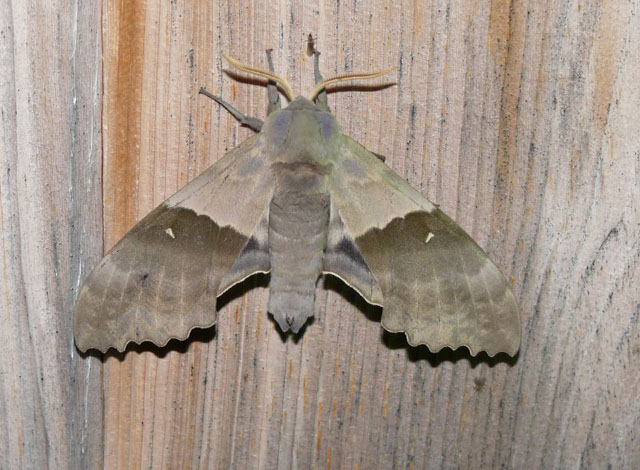Sphinginae subfamily
Sphingini tribe:
 |
Ceratomia amyntor
WO,
Elm Sphinx/Four-horned Sphinx:
Fw upperside: brown with dark brown and white
markings including white costal area near wing base, dark
streaks along veins, and white spot in cell. Hw upperside:
light brown and has dark brown band along
outer margin. Larvae feed on Elm (Ulmus), birch (Betula), basswood (Tilia), and
cherry (Prunus). |
 |
Ceratomia catalpae
WO,
the Catalpa Sphinx: The upperside of the forewing is yellowish brown
with no white markings, but there are indistinct black lines and
dashes. The cell spot is gray with a black outline and the upperside
of the hindwing is yellowish brown with obscure lines.
The larvae feed in large groups and are much more
spectacular than the moths. Catalpa is the larval host. |
 |
Ceratomia undulosa
WO/DS/JSR, Waved
Sphinx: Fw Upperside: pale brownish gray with wavy black
and white lines and black-outlined white cell spot. Hw Upperside:
gray with diffuse darker bands.
Some individuals are almost black; others light
yellowish brown. Note black and white collar separating thorax from
abdomen.
|
Ceratomia undulosa,
June 9, 21, 2008, Athol, courtesy of Dave Small.
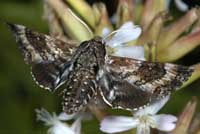 |
Dolba hyloeus
USGS/DS/BH, the Pawpaw Sphinx
The upperside of the forewing is dark brown with a dusting of white
scales. Some moths have patches of reddish or yellowish brown on the
wings. Larvae are not limited to pawpaw.
|
Dolba hyloeus,
June 14, 2008, Athol, courtesy of Dave Small.
Dolba hyloeus,
June 14, 2009, Athol, courtesy of Betsy Higgins.
 |
Lapara bombycoides
USGS/BHJSR, the
Northern Pine Sphinx
The upperside of the forewing is gray with heavy black bands. The
upperside of the hindwing is brownish gray with no markings.
The underside is rather plain.
|
Lapara bombycoides adult moth, Florence, Hampshire County, Massachusetts, June 5, 2010;
Athol, Worcester County, Massachusetts, June 18, 2011,
courtesy of Betsy Higgins.
 |
Lapara coniferarum
WO, Southern Pine Sphinx:
Fw: gray with two (sometimes one or
three) black dashes near wing center; other markings are usually
diffuse. Hw: uniform brown-gray.
This species does not have more sharply contrasting black
markings of fresh Lapara bombycoides.
|
 | This species is probably present in Worcester County..
The upperside of the forewing is gray-brown with wavy lines, black
dashes, and one or
two small white spots near the center of the costa.
|
 |
Manduca jasminearum
WO Ash Sphinx.
Fw: gray to grayish brown with a black line
running from the middle of the costa to the middle of the outer
margin; the line may be broken near the margin. There is a splash of
brown around the cell spot. The upperside of the hindwing is mostly
black, with gray at the lower margin. questionable
|
 |
Manduca quinquemaculatus
WO Five-spotted Hawkmoth.
This species is not recorded in Worcester, but, if you grow tomatoes, you have probably encountered it.
|
 |
Manduca sexta WO, Carolina Sphinx.
This species is not officially recorded in Worcester, but if you grow
tomatoes, you have probably encountered it..
Larvae get very large and can strip a tomato plant. |
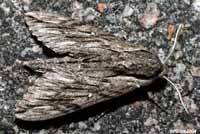 |
Paratrea plebeja
WO, Plebian Sphinx.
This species is not officially recorded in Worcester County, but probably is present. The upperside of the forewing is gray with indistinct black
and white markings.
|

|
Sphinx canadensis
WO,
Sphinx canadensis, the Canadian Sphinx, is not common, and is not
often reported anywhere,
but it might be present in Worcester County as it is reported from
Berkshire.
Larval hosts are white ash (Fraxinus americana) and blueberry
(Vaccinium).
|
 |
Sphinx chersis
USGS/DS, Northern Ash Sphinx/Great Ash
Sphinx. Fw: soft dark gray to blue-gray
with a series of black dashes, one of which reaches the wing tip. Hw: black with blurry pale gray bands.
Larval hosts are ash, lilac, privet, cherry, and quaking aspen.
|
Sphinx chersis, Athol, July 21, 2008, July 19, 2010, Dave Small
Sphinx chersis, Gardner, June 16, 2010, Brigitte Flick
 |
Sphinx drupiferarum
WO, Wild Cherry Sphinx:
This species is not officially recorded, but I suspect it is
present. Forewings, long and slender, are held
close to the body when the moth is at rest.
|
 |
Sphinx gordius
WO, Apple Sphinx.
This species is probably present in Worcester County.
Colouration and markings are highly variable from one specimen to
another. Fw fringes are mostly black with some white; those on the hindwing are mostly white with a
few black patches. |
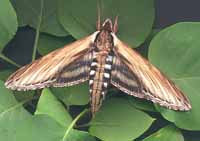 |
Sphinx kalmiae
USGS/DSJSR,
Laurel Sphinx.
The lower forewings are predominantly brownish-yellow with a fairly
wide dark bar along the inner margin. At rest the wings hug the body,
giving the moth a long slender look.
|
Sphinx kalmiae, June 9, 2008, Athol, courtesy of Dave Small.
Sphinx kalmiae, June 7, 2009, Athol, courtesy of Dave Small.
 |
Sphinx luscitiosa
USGS,
the Canadian Sphinx or
Clemen's Sphinx:
Upperside of fw is yellowish gray in males and pale
gray with faint yellow tint in females. Dark
border on outer margin widens as it approaches inner margin.
Upperside of hw is deep yellow in males,
pale yellow in females; both with wide black border.
|
 |
Sphinx poecila
WO/DSJSR, the Poecila
Sphinx.
If you have blueberries in the woods, then you probably have the
Poecila Sphinx.
They are pretty common here on Prince Edward Island, but don't fly
too far south of Massachusetts, being replaced by
Sphinx gordius in Connecticut.
|
Sphinx poecila, June 26, 2008, Athol, courtesy of Dave Small.
Smerinthini Tribe:
 |
Amorpha juglandis
WOJSR,
Walnut Sphinx:
Highly variable; sometimes wings of an individual
may be all one color or may have several colors, ranging from pale
to dark brown, and may have white or pink tinge. Patterns range
from faint to pronounced.
This is first Sphinx species I reared as a boy in New Jersey.
See file for female; she is different. |
 |
Pachysphinx modesta
USGS/DS
the Modest Sphinx or Poplar Sphinx.
This moth has a large, heavy body,
and females can be remarkably plump.
|
Pachysphinx modesta, June 8, 2008, Athol, David Small.
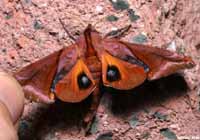 |
It is recorded for northeastern Massachusetts and western Connecticut
so may be present in Worcester County.
It would be more common
in southeastern Massachusetts and is a relatively uncommon species.
|
 |
Paonias excaecata
USGS/DS/BHJSR, Blinded Sphinx.
Named for the dull grey-blue spot in the hindwing, this moth has a
wide distribution and is probably common in Worcester County.
I regularly see them on Prince Edward Island, and they are reported
as far south as Florida.
|
Paonias excaecata, Athol,
June 10, 2008, courtesy of Dave Small.
Paonias excaecata, Athol,
June 19, 2011, courtesy of Betsy Higgins.
 |
Paonias myops
USGS/DS, Small-eyed Sphinx.
Named for the small eye-spot in the hindwing, this moth has a wide
distribution and is probably common in Worcester County.
I regularly see them on Prince Edward Island, and they are reported
as far south as Florida.
|
Paonias myops, Athol,
June 10, 2008, courtesy of Dave Small.
 |
Reported in Berkshire and Essex, it is probably also in Worcester
near the southern limit of its eastern range.
I never saw one in New Jersey. At my home in Montague, P.E.I.,
Canada, they are quite common. |
 |
Smerinthus jamaicensis
WO/DS, Twin-spotted Sphinx.
This moth is widely distributed and fairly common so I suspect it
is in Worcester County..
Along the East Coast, it flies from P.E.I. to Florida.
|
Smerinthus jamaicensis, Athol, June 4, 2011, Dave Small
Macroglossinae subfamily
Dilophonotini tribe:
See Hemaris comparison to help distinguish the next three species.
 |
Hemaris thysbe
WO, the Hummingbird Clearwing
It is not difficult to see why many gardeners would mistake an
Hemaris thysbe moth for a small hummingbird as it hovers, sipping
nectar from flowers through a long feeding tube.
|
 |
Hemaris diffinis
WO/CK, the
Snowberry Clearwing or Bumblebee Moth
Adults mimic bumblebees and are quite variable. The wings are
basically clear, with dark brown to brownish-orange veins, bases and
edges. The thorax is golden-brown to dark greenish-brown.
|
Hemaris diffinis, Royalston, May 30, 2009, Carl Kamp
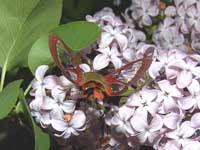 |
Hemaris gracilis
WO, the
Slender Clearwing or Graceful Clearwing
Hemaris gracilis is distinguished from similar species by a pair of
red-brown bands on the undersides of the thorax, which varies from
green to yellow-green dorsally and sometimes brown with white
underneath. They have a red abdomen.
|
Philampelini tribe:
 |
Eumorpha achemon WO, Achemon Sphinx.
Adults nectar from flowers of Japanese honeysuckle
(Lonicera japonica), petunia (Petunia hybrida), mock
orange (Philadelphus coronarius), and phlox (Phlox).
Note differences between this moth and Pandorus Sphinx.
|
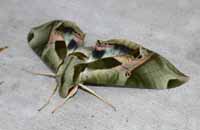 |
Eumorpha pandorus
USGS, the Pandorus Sphinx.
If you have Grape or Virginia Creeper nearby, then you probably have
this species.
I often get asked to identify larvae from areas where they have not
previously been reported. |
Macroglossini tribe:
 |
Amphion floridensis
WO, Nessus Sphinix.
This day flier is widely distributed in surrounding states and in
eastern Massachusetts.
If you have Virginia Creeper, you
probably have the Nessus Sphinx.
Two bright, distinct, narrow yellow
bands are often visible on the abdomen.
|
 |
Darapsa choerilus
USGS/DS//BHJSR, the Azalea Sphinx
They are common in New Jersey and common
here on Prince Edward Island.
You will often see this species listed as Darapsa pholus,
especially in older literature. It is almost cetrtainly present.
|
Darapsa choerilus
June 9, 22, 2008, Athol, courtesy of Dave Small.
Darapsa choerilus, Athol, June 18, 2011, Betsy Higgins.
 |
Darapsa myron
WO/DS/BHJSR, the Virginia Creeper Sphinx or the Grapevine Sphinx
It is widely reported as far north as southern Maine. If you have
the foodplants indicated in the common names, you probably have this
species nearby.
|
Darapsa myron
June 14, 21, 2008, Athol, courtesy of Dave Small.
Darapsa myron
June 14, 2009, Athol, courtesy of Betsy Higgins.
 |
If you have hydrangea growing near a stream, then you may have the
Hydrnagea Sphinx. It has not been widely reported, however, and
probably is uncommon.
|
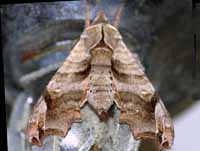 |
Deidamia inscriptum
USGS,
Lettered Sphinx.
The moth's outer margin of the forewing is deeply scalloped.
The upperside is light brown with dark brown markings.
There is a small black and white spot near the tip.
The upperside of the hindwing is orange-brown with a dark brown outer margin and median line.
|
 |
Hyles gallii
WO/BHJSR, the Bedstraw Hawk Moth
or Gallium Sphinx.
This moth is somewhat similar to Hyles lineata, but it lacks the
numerous thin white lines of that species and has an irregular creamy
bar running form the apex to the body.
|
Hyles gallii, Athol, June 18-19, 2011, Betsy Higgins
 |
Hyles lineata WO, the White-lined Sphinx
This species is reported in Essex and Berkshire and should be
present.
It is a strong migrator from the south,
and there are records from the east, west and to the north. |
 |
This moth is very much under reported. It is a
rapid day flier so is probably not in too many collections. Grape is a popular larval host.
|
Sphecodina abbottii Athol, June 1, 2011, Dave Small.
|
|
